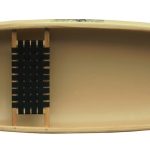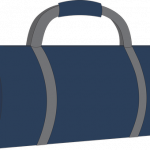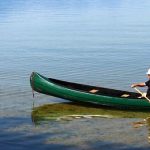When purchasing a canoe, there are many things to think about. The effectiveness and practicality of the canoe depends on its dimensions, form, and constituents, which will determine its capability in different circumstances.
Different dimensions of a canoe will affect its performance. Length gives you speed, but width gives you stability. A canoe that is constructed properly should have measurements of length, width, and depth that will enable it to be effective in its intended use.
The intent could be to go angling, extended journeys, or waterways with strong currents.
Initially deciding the purpose of your canoeing trip can enable you to pinpoint the correct canoe, therefore avoiding getting overwhelmed with the specifics.
To aid in selecting the right canoe, one may want to consult a buying guide that provides a thorough overview of what to consider when making a decision.
Discover additional information about the varieties of canoes and how certain attributes, such as size, breadth, boat form, and more, have an impact on its performance.
How to Choose the Right Canoe
CANOE BASICS
Before you delve into the world of canoe designs, it is important that you have a fundamental understanding of canoeing.
It is essential to recognize the distinguishing features of each canoe- the sizes to be mindful of, the outline of the vessel, and what material it is composed of!
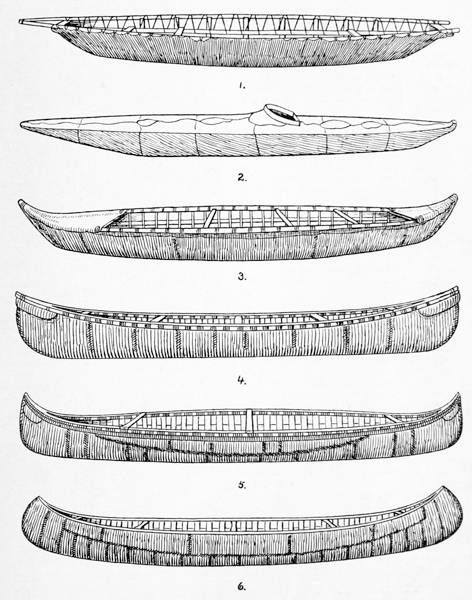
Canoe Types
Anytime a canoe is designed, it will have a certain set of advantages and disadvantages. A vessel that has been constructed with the purpose of fishing will not be well-suited for sailing in open seas. A vessel designed for traversing quickly-moving waterways won’t provide the steadiness needed for angling. Here are a few of the most common types of canoe:
1. Tripping canoes
Tripping canoes are built for long-distance trips. It’s possible that you will also come across them being referred to as touring or expedition canoes. These boats are designed to be able to transport cargo (or a number of paddlers) for a great distance. Typically, they are longer and thinner than other types of boats in order to stay on track and go at a faster speed.
2. Sporting canoes
Sporting canoes are designed for hunters and anglers. They tend to be shorter and wider than others.
This provides them with a secure spot where it is simple for people to go fishing and hunting. When you require assistance, they provide more assistance, and they’re better equipped to take on the disturbance triggered by catching a fish.
3. Recreational canoes
A canoe designed for leisure use is an appropriate vessel for gliding across peaceful waters. These vessels are ideal for families, and some of the best ones are used for birdwatching, taking pictures, or going out on lake excursions for the day.
They’re stable, and easy to paddle. These boats generally range in sizes of medium characteristics, which means they can be useful for many practical purposes, but they are typically not designed for fishing in extreme conditions, on turbulent waters, or racing at high rates.
CANOE SIZES AND DIMENSIONS
This is the easiest to deal with. Canoes that are used for tripping must be at least 16 feet long but cannot exceed a length of 18 feet. A sixteen-foot canoe is large enough for two individuals to fit in with all the equipment they need for a seven-day excursion.
If you plan on going somewhere longer, or you have a need to bring an extra party (a child or pet), you should look into a 17 ft boat or even an 18 ft boat. The disadvantage of having a longer boat is how it performs when on the water.
A 17 foot or 18 foot canoe will be speedy on the water, but it will quickly plunge underwater when encountering whitewater. The 16 foot boat is well-suited to navigating through a winding river, due to its exceptional maneuverability.
However, it may not function as well in lake conditions, such as waves, as it will be slower than other boats.
The measurements of a canoe have an influence on how it behaves and navigates. The choice of whether one requires greater width, length, or depth is contingent on the necessity for speediness, steadiness, or a combination of both.
Length
The size of a canoe has an impact on its motion through the water. Longer boats track straighter. Longer kayaks go at higher speeds, have a further reach, and have the capacity to carry heavier loads than the smaller models.
However, shorter kayaks can be much easier to maneuver.
Width
Wider canoes tend to be more stable. Boats are an excellent vessel for fishing, as you are likely to experience an eventful catch which could cause instability on the boat and can lead to an unexpected tipping.
They are perfect for activities such as taking pictures, wherein a steady hand is essential. Canoes that are more slender will typically move quicker with more effective paddling.
Depth
The depth of a canoe is determined by how far it is from the top of the side rails (known as gunwales) to the bottom of the vessel. Boats with a deep draft can help prevent the influx of water and can hold considerable amounts of weight.
Nevertheless, vessels that have high sides will be more vulnerable to gusts of wind.
CANOE DESIGNS AND SHAPES
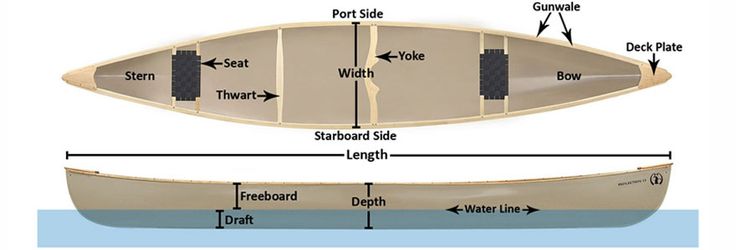
It is clear that there is more to the creation of a canoe than just basic measurements. The form of the boat has an impact on how it travels and handles. Different shapes are great for different types of paddling.
Hull Shape
The bottom of the canoe affects its stability. There are in reality two types of balance for a canoe. ““Initial stability” is a term used to describe the capability of a boat to remain upright in calm waters.”
Secondary stability refers to the amount of effort that needs to be exerted to capsize the boat when the water is choppy.
Generally, a curved bottom assists a boat in staying upright when it is being rocked, while a flat floor allows one to keep their balance when the water is smooth.
There are numerous varieties of hull shapes on the market which strike a balance between flat and rounded floorings. These various forms create vessels that excel in diverse circumstances.
Flat-Bottom Canoes
Flat bottoms have lots of initial stability. They perform excellently in calm water and are a great choice for fishing purposes. It’s straightforward to maneuver them, as the majority of the vessel is on top of the water’s surface.
Once you give them a heavy load of equipment, they become sluggish.
Rounded Canoes
Rounded bottoms are not the best in terms of initial steadiness on flat water, but they make up for this with incredible secondary stability.
That suggests they are highly effective in choppy water conditions. These boats are typically constructed to provide maximum efficiency while navigating whitewater rapids.
Shallow Arch Canoes
Shallow arches compromise between a flat and round bottoms. They provide a satisfactory amount of stability when there are calm seas and superior stability in turbulent waters.
Flat-bottom boats do not move and stay in line as proficiently as boats with vee bottoms do.
This type of canoe has had a long history, with it being constructed from materials such as birch bark, wood and canvas in earlier times.
V-Bottom Canoes
V-bottom vessels are comparable to shallow-arches, but at the center, they possess a much clearer outline. The shape looks like a “V” rather than a rounded shape, hence the name.
These boats have amazing capabilities when it comes to turning and maintaining a proper course, as well as a steadiness that stands up to calm and turbulent waters.
Rocker
Another design feature that affects performance is the rocker. “The shape of a canoe is characterized by its curvature along its length, also known as ‘rocker’.” Some canoes run in a fairly smooth progression from front to back.
The shape of some boats will resemble an archer’s bow, with a considerable amount of curving occurring along its body.
The more curved a boat is, the less it will travel distance. If only the center of the vessel is in the water, it will more closely act like a shorter canoe, making it easy to maneuver, but it will not stay in a straight line as well.
A slight curve in the keel can provide some extra handling capacity to a lengthy craft, without significantly reducing the boat’s tracking ability.
Side Shape
The form of the edges has an impact on how well a canoe operates as well, with benefits of increased equilibrium or quicker rowing conflicting with each other.
Tumblehome
Tumblehome canoes curve inwards as they go up. The edges of the canoe will face inward towards the person paddling the vessel at the top.
A curvature in the sides of a boat near the gunwale can make it easier for a paddler to lean out and take a correct vertical forward stroke. This can be especially helpful when attempting to move a bigger vessel using a paddle.
A canoe with an excessive amount of tumblehome shape can create insecurity when the boat is tilted, however usually, a small degree of tumblehome does not disrupt balance notably.
Flare
Flare canoes have an opposite shape to tumblehome. The dimensions of the canoe are such that it is broadest at the top and tapers down at the base. A flared canoe is extra stable when leaned. It is generally possible to tip a flared canoe up to the edges without any problems.
Straight
Canoes with perpendicular walls have vertical sides. The hull of the boat is designed in a way that captures the positive characteristics of a flare and the ease of mobility of a tumblehome.
CANOE MATERIALS
The materials used to make canoes are as diverse as the size and shape that they come in. It’s hard to imagine that the selection of the substances employed for the fabrication of a canoe began with a stroll in the woods.
It appears that everything is completed in the science laboratory.
When deciding what material to use to build a canoe, it is important to evaluate both its weight and its strength. Some materials form a canoe that is almost unbreakable, but they are very difficult to carry over land.

While other materials are so light they feel like a feather, but they are very frail and fragile. Here are some of the choices on the market.
Wooden Canoes
I’ve heard several folks who prefer the classic style say that a canoe, stemming from Peterborough, Ontario, must be made out of wood and canvas whereas a boat can be crafted out of any material.
In spite of the costly price tag, excessive maintenance needed, and bulky weight while wet, wooden canoes aren’t exactly the best choice for boating in the great outdoors.
Yet somehow, there’s still a special feeling one gets when taking a paddle to the river in one.
Key Characteristics:
- Classic and nostalgic.
- Require maintenance and can be heavy when wet.
Aluminum Canoes
The aluminum canoe, formerly known as the “Grumman canoe,” is generally employed for institutional purposes due to its competitive cost and strength.
Although aluminum canoes are not as attractive as ones made of wood and canvas.
They are quite heavy to lug between water sources, the bottom tends to get caught on rocks when being dragged. The thumping sound that happens every time a paddle strikes the sides is hard to ignore.
If a more subtle approach is more your style and you don’t want birds and beasts to be aware of your presence on the lake, then the aluminum canoe is the boat for you.
Key Characteristics:
- Affordable and sturdy.
- Heavy to carry and noisy on the water.
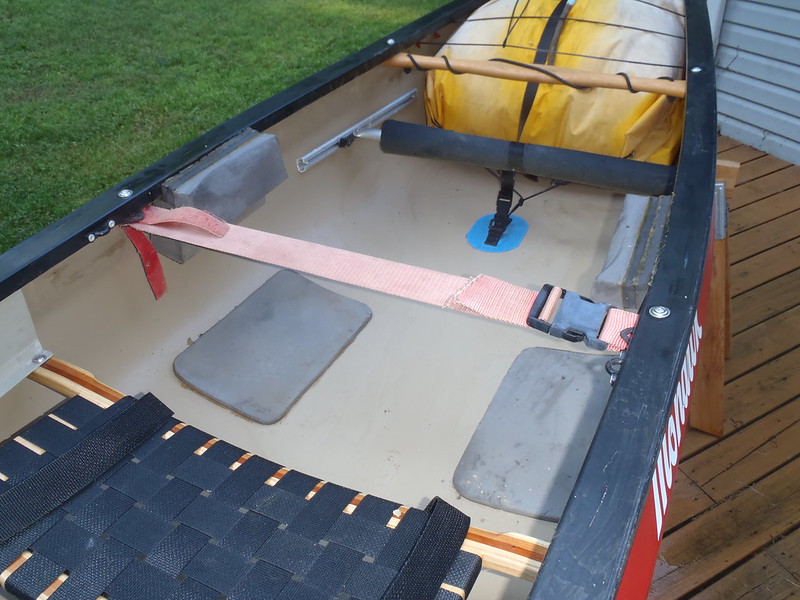
Thermoform Canoes
A thermoformed canoe is created by warming up a sheet of plastic and shaping it over a canoe form.
They are light enough to carry around, exceedingly long-lasting, and one of the most common substances used to make recreational canoes.
Key Characteristics:
- Lightweight and durable.
- Common choice for recreational canoes.
Polyethylene Canoes
It is likely that the most frequently seen type of canoe for sale currently is one made from rotomolded polyethylene. These canoes are the cheapest option but are still very robust, and are made up of three layers of polyethylene plastic.
The manufacture of these bombers canoes involves pouring plastic pellets into a hot mold and then rotating the mold.
Key Characteristics:
- Cost-effective and robust.
- Made of three layers of polyethylene plastic.
Royalex Canoes (Discontinued)
Royalex canoes, which were once a dominant type of canoe material, are no longer produced. This plastic material is made up of a foam interior sandwiched between sheets of ABS and has a vinyl exterior. Its robustness and malleability make it an apparent selection for whitewater canoers.
Hope that the river you are navigating doesn’t require a lot of dragging your boat, as Royalex vessels can be extremely heavy.
They may not last as long, but you would be less likely to experience an inguinal hernia while travelling.
Key Characteristics:
- Foam interior for durability.
- Heavier than other materials and no longer produced.
Fiberglass Canoes
A few years ago, fiberglass was the most popular material used in the making of canoes. Fiberglass produces a boat that is of moderate strength but light in weight.
It is constructed by blending strips of fabric or chopped glass with resin, which is then sprayed into a form.
Some fiberglass models are of incredible quality, while others do not meet expectations. I’d stay away from the chopped glass types.
They are not of high quality and it is not worth the effort to bring them with you on a faraway canoe journey.
I would avoid fiberglass completely, unless it is the only option within your budget.
Key Characteristics:
- Moderate strength and lightweight.
- Quality varies; some models may not meet expectations.
Kevlar Canoes
Kevlar is more expensive than fiberglass. But it’s lighter to carry and has added strength. Some producers create their own special blend of Kevlar and fiberglass.
A few people have created their own version of Kevlar and put it around existing canoe forms.
Be aware if you are making a purchase; ensure that you do not get taken advantage of by a salesperson who is not well-informed. I’m delighted with the services of the Voyager Canoe Company in Millbrook, Ontario.
The proprietor has a tremendous knack for combining contemporary science with customary practices.
Key Characteristics:
- Lightweight and strong.
- Some models offer a blend of Kevlar and fiberglass
Choosing the Right Canoe for Your Needs
Now that you have a comprehensive understanding of canoe types, sizes, designs, and materials, it’s time to choose the right canoe for your specific needs.
Consider your intended use, the water conditions you’ll encounter, and your preferences in terms of weight and durability.
Remember that the perfect canoe is one that suits your unique requirements.
Maintaining Your Canoe
Once you’ve selected your ideal canoe, proper maintenance is essential to ensure its longevity and optimal performance.
Regularly inspect your canoe for damage, clean it after each use, and store it appropriately. With proper care, your canoe will provide years of enjoyable adventures.
A BOAT FOR EVERY OCCASION
It doesn’t matter what your motives are for getting into a canoe – there is one specifically suitable for you. Perhaps you would like to put more effort into developing your abilities as an angler.
Maybe you want to introduce your kids to paddling. Perhaps you would prefer to spend a pleasant day at the lake. Enjoy yourself and make sure to be secure, and there is no incorrect technique for partaking in canoeing.
Happy paddling!

